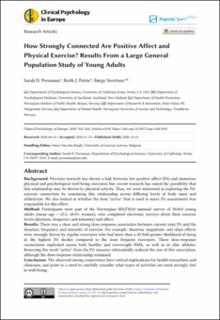| dc.contributor.author | Pressman, Sarah D | |
| dc.contributor.author | Petrie, Keith James | |
| dc.contributor.author | Sivertsen, Børge | |
| dc.date.accessioned | 2021-02-23T12:37:55Z | |
| dc.date.available | 2021-02-23T12:37:55Z | |
| dc.date.created | 2021-01-20T10:38:34Z | |
| dc.date.issued | 2020 | |
| dc.identifier.citation | Clinical Psychology in Europe. 2020, 2 (4), 1-21. | en_US |
| dc.identifier.issn | 2625-3410 | |
| dc.identifier.uri | https://hdl.handle.net/11250/2729809 | |
| dc.description.abstract | Background: Previous research has shown a link between low positive affect (PA) and numerous physical and psychological well-being outcomes but, recent research has raised the possibility that this relationship may be driven by physical activity. Thus, we were interested in exploring the PA-exercise connection by examining this relationship across differing levels of body mass and athleticism. We also looked at whether the item “active” that is used in many PA assessments was responsible for this effect. Method: Participants were part of the Norwegian SHoT2018 national survey of 50,054 young adults (mean age = 23.2, 68.9% women), who completed electronic surveys about their exercise levels (duration, frequency and intensity) and affect. Results: There was a clear and strong dose-response association between current state PA and the duration, frequency and intensity of exercise. For example, duration, magnitude, and slope effects were strongly driven by regular exercisers who had more than a 20-fold greater likelihood of being in the highest PA deciles compared to the least frequent exercisers. These dose-response connections replicated across both healthy and overweight BMIs, as well as in elite athletes. Removing the word “active” from the PA measure substantially reduced the size of this association, although the dose-response relationship remained. Conclusion: The observed strong connections have critical implications for health researchers and clinicians, and point to a need to carefully consider what types of activities are most strongly tied to well-being. | en_US |
| dc.language.iso | eng | en_US |
| dc.publisher | PsychOpen | en_US |
| dc.rights | Navngivelse 4.0 Internasjonal | * |
| dc.rights.uri | http://creativecommons.org/licenses/by/4.0/deed.no | * |
| dc.title | How Strongly Connected are Positive Affect and Physical Activity? Results from a Large General Population Study of Young Adults? | en_US |
| dc.type | Journal article | en_US |
| dc.description.version | publishedVersion | en_US |
| dc.source.pagenumber | 1-21 | en_US |
| dc.source.volume | 2 | en_US |
| dc.source.journal | Clinical Psychology in Europe | en_US |
| dc.source.issue | 4 | en_US |
| dc.identifier.doi | 10.32872/cpe.v2i4.3103 | |
| dc.identifier.cristin | 1875223 | |
| dc.description.localcode | This is an open access article distributed under the terms of the Creative Commons Attribution 4.0 International License, CC BY 4.0, which permits unrestricted use, distribution, and reproduction, provided the original work is properly cited. | en_US |
| cristin.ispublished | true | |
| cristin.fulltext | original | |

